Complete Solutions to Problems of chapter CENTER OF MASS of Class 12 book with complete answers and questions
| Class 12 | PHYSICS |
| Chapter | CENTER OF MASS |
| RESNICK AND HALLIDAY | Problems |
| Number Of Questions | 46 |
| Academic Year | 2023-24 |
Three particles of masses `1kg`, `2kg` and `3kg` are placed at the corners A, B and C respectively of an equilateral triangle ABC of edge `1m`. Find the distance of their centre of mass from A.
View SolutionThree uniform thin rods, each of length L=24 cm, form an inverted U. The vertical rods each have a mass of 14 g, the horizontal rod has a mass of 42 g. What are (a) the x coordinate and (b) the y coordinate of the system's center of mass?
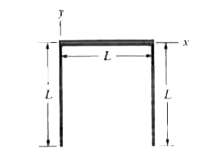
View SolutionA cubical box that has been constructed from uniform metal plate of negligible thickness. The box is open at the top and has edge length L=50 cm. Find (a) the x coordinate, (b) the y coordinate, and (c) the z coordinate of the center of mass of the box.

View SolutionA 1000 kg automobile is at rest at a traffic signal. At the instant the light turns green, the auto mobile starts to move with a constant acceleration of `3.0 m//s^2`. At the same instant a 2000 kg truck, traveling at a constant speed of 8.0 m/s, overtakes and passes the automobile. (a) How far is the com of the automobile-truck system from the traffic light at t = 5.0 s? (b) What is the speed of the com then?
View SolutionA big olive (m=0.50 kg) lies at the origin of an xy coor dinate system, and a big Brazil nut (M = 1.5 kg) lies at the point (1.0,2.0) m. At t=0, a force `vecF_o = (2.0hati + 3.0hatj)N` begins to act on the olive, and a force `vecF_n = (-3.0hati – 2.0hatj)N` begins to act on the nut. In unit-vector notation, what is the displacement of the center of mass of the olive-nut system at t = 4.0 s, with respect to its position at 1= 0?
View SolutionTwo skaters, one with mass 75 kg and the other with mass 40 kg, stand on an ice rink holding a pole of length 10 m and negligible mass. Starting from the ends of the pole. the skaters pull themselves along the pole until they meet. How far does the 40 kg skater move?
View SolutionRichard, of mass 80 kg, and Camelia, who is lighter, are in a 30 kg canoe on a lake. When the canoe is at rest in the placid water, they exchange seats, which are 3.0 m apart and symmetrically located with respect to the canoe's center. If the canoe moves 45 cm horizontally relative to a pier post, what is Camelia's mass?
View SolutionA 0.70 kg ball moving horizontally at 6.0 m/s strikes a vertical wall and rebounds with speed 3.5 m/s. What is the magnitude of the change in its linear momentum?
View SolutionA ball of mass 50 g moving at a speed of 2.0 m/s strikes a plane surface at an angle of incidence `45^0`. The ball is reflected by the plane at an equal angle of reflection with the same speed. Calculate (a). the magnitude of the change in momentum of the ball (b). the change in the magnitude of the mometum of the ball.
View SolutionIn February 1955, a paratrooper fell 370 m from an air plane without being able to open his chute but happened to land in snow. suffering only minor injuries. Assume that his speed at impact was 56 m/s (terminal speed), that his mass (including gear) was 85 kg, and that the magnitude of the force on him from the snow was at the survivable limit of `1.2 xx 10^5` N. What are (a) the minimum depth of snow that would have stopped him safely and (b) the magnitude of the impulse on him from the snow?
View SolutionA `5.0g` bullet moving at `100m//s` strikes a log. Assume that the bullet undergoes uniform deceleration and stops in `6.0cm`. Find (a) the time taken for the bullet to stop, (b) the impulse on the log and (c) the average force experienced by the log.
View SolutionIn a common but dangerous prank, a chair is pulled away as a person is moving downward to sit on it, causing the victim to land hard on the floor. Suppose the victim falls by 0.50 m, the mass that moves downward is 75 kg, and the collision on the floor lasts 0.088 s. What are the magnitudes of the (a) impulse and (b) average force acting on the victim from the floor during the collision?
View SolutionA `3.0kg` block slides on a frictionless horizontal surface, first moving to the left at `50m//s`. It collides with a spring as it moves left, compresses the spring and is brought to rest momentarily. The body continues to be accelerated to the right by the force of compressed spring. Finally, the body moves to the right at `40m//s`. The block remains in contact with the spring for `0.020s`. What were the magnitude and direction of the impulse of the spring on the block? What was the spring's average force on the block?
View SolutionIn tae-kwon-do, a hand is slammed down onto a target at a speed of 13 m/s and comes to a stop during the 5.5 ms collision. Assume that during the impact the hand is independent of the arm and has a mass of 0.70 kg. What are the magnitudes of the (a) impulse and (b) average force on the hand from the target?
View SolutionA ball of mass 1.00 kg is attached to a loose string fixed to a ceiling. The ball is released from rest and falls 2.00 m, where the string suddenly stops it. Find the impulse on it from the string.
View SolutionJumping up before the elevator hits. After the cable snaps and the safety system fails, an elevator cab free-falls from a height of 36 m. During the collision at the bottom of the elevator shaft, a 90 kg passenger is stopped in 5.0 ms. (Assume that neither the passenger nor the cab rebounds.) What are the magnitudes of the (a) impulse and (b) average force on the passenger during the collision? If the passenger were to jump upward with a speed of 7.0 m/s relative to the cab floor just before the cab hits the bottom of the shaft, what are the magnitudes of the (c) impulse and (d) average force (assuming the same stopping time)?
View SolutionFigure shows a 0.300 kg baseball just before and just after it collides with a bat. Just before, the ball has velocity `vecv_1` of magnitude 12.0 m/s and angle `theta_1=35.0^@` Just after, it is traveling directly upward with velocity `vecv_2` of magnitude 10.0 m/s The duration of the collision is 2.00 ms. What are the (a) magnitude and (b) direction (relative to the positive direction of the x axis) of the impulse on the ball from the bat? What are the (c) magnitude and (d) direction of the average force on the ball from the bat?
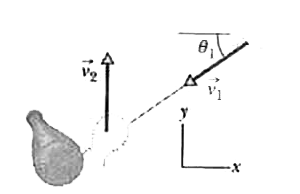
View SolutionA 0.25 kg puck is initially stationary on an ice surface with negligible friction. At time t = 0, a horizontal force begins to move the puck. The force is given by `vecF=(12.0-3.00t^2)hati`, with `vecF` in newtons and t in seconds, and it acts until its magnitude is zero. (a) What is the magnitude of the impulse on the puck from the force between t= 0.750 s and t = 1.25 s? (b) What is the change in momentum of the puck between t=0 and the instant at which F=0?
View SolutionA particle of unknown mass is acted upon by a force `vecF=(100e^(-2t)hati) N`. If at t = 0.00 s the particle is at rest, for the time interval t=0.00 s to t= 2.00 s find (a) the impulse on the particle and (b) the average force on the particle.
View SolutionA man of mass `m_1` = 80 kg is standing on a platform of mass `m_2` = 20 kg that lies on a frictionless horizontal surface. The man starts moving on the platform with a velocity `v_r` = 10 m/s relative to the platform. Find the recoil speed of the platform.
View SolutionA space vehicle is traveling at 4800 km/h relative to Earth when the exhausted rocket motor (mass 4m) is disengaged and sent backward. The relative speed between motor and command module (mass m) is then 82 km/h. What is the speed of the command module relative to Earth just after the separation ?
View SolutionA 15.0 kg package is moving at a speed of 10.0 m/s vertically upward along a y axis when it explodes into three fragments: a 2.00 kg fragment is shot upward with an initial speed of 20.0 m/s and a 3.00 kg fragment is shot in the positive direction of a horizontal x axis with an initial speed of 5.00 m/s. Find (a) the speed of the third fragment right after the explosion and (b) the total kinetic energy provided by the explosion.
View SolutionIn Fig. a stationary block explodes into two pieces L and R that slide across a frictionless floor and then into regions with friction, where they stop. Piece L. with a mass of 2.0 kg, encounters a coefficient of kinetic friction `mu_L` = 0.35 and slides to a stop in distance `d_L` =0.15 m. Piece R encounters a coefficient of kinetic friction `mu_R`=0.50 and slides to a stop in distance `d_R` =0.30 m. What was the mass of the block?

View SolutionA 4.0 kg mess kit sliding on a frictionless surface explodes into two 2.0 kg parts: 3.0 m/s, due north, and 6.0 m/s, `30^@` north of east. What is the original speed of the mess kit ?
View SolutionParticle A and particle B are held together with a compressed spring between them. When they are released, the spring pushes them apart, and they then fly off in opposite directions, free of the spring. The mass of A is 2.00 times the mass of B, and the energy stored in the spring was 80 J. Assume that the spring has negligible mass and that all its stored energy is transferred to the particles. Once that transfer is complete, what are the kinetic energies of (a) particle A and (b) particle B?
View SolutionA bullet of mass 10 g strikes a ballistic pendulum of mass 2.0 kg. The center of mass of the pendulum rises a vertical distance of 12 cm. Assuming that the bullet remains embedded in the pendulum, calculate the bullet's initial speed.
View SolutionA 5.20 g bullet moving at 700 m/s strikes a 700 g wooden block at rest on a frictionless surface. The bullet emerges, traveling in the same direction with its speed reduced to 450 m/s. (a) What is the resulting speed of the block? (b) What is the speed of the bullet-block center of mass ?
View SolutionA completely inelastic collision occurs between two balls of wet putty that move directly toward cach other along a vertical axis. Just before the collision, one ball, of mass 3.0 kg, is moving upward at 20 m/s and the other ball, of mass 2.0 kg, is moving downward at 10 m/s. How high do the combined two balls of putty rise above the collision point? (Neglect air drag.)
View SolutionBlock A has a mass `3kg` and is sliding on a rough horizontal surface with a velocity `u_A=2m//s` when it makes a direct collision with block B, which has a mass of `2kg` and is originally at rest. The collision is perfectly elastic. Determine the velocity of each block just after collision and the distance between the blocks when they stop sliding. The coefficient of kinetic friction between the blocks and the plane is `mu_k=0.3` ( Take `g=10m//s^2`)
View SolutionIn the "before" part of Fig., car A (mass 1100 kg) is stopped at a traffic light when it is rear-ended by car B (mass 1400 kg). Both cars then slide with locked wheels until the frictional force from the slick road (with a low `mu_k` of 0.10) stops them, at distances `d_A` = 8.2 m and `d_B` = 6.1 m. What are the speeds of (a) car A and (b) car B at the start of the sliding, just after the collision? (c) Assuming that linear momentum is conserved during the collision, find the speed of car B just before the collision. (d) Explain why this assumption may be invalid.

View SolutionIn Fig. , a ball of mass m = 60 g is shot with speed `v_i` = 22 m/s into the barrel of a spring gun of mass M= 240 g initially at rest on a frictionless surface. The ball sticks in the barrel at the point of maximum compression of the spring. Assume that the increase in thermal energy due to friction between the ball and the barrel is negligible. (a) What is the speed of the spring gun after the ball stops in the barrel? (6) What fraction of the initial kinetic energy of the ball is stored in the spring?

View SolutionTwo titanium spheres approach each other head-on with the same speed and collide elastically. After the collision, one of the spheres, whose mass is 250 g, remains at rest. (a) What is the mass of the other sphere? (b) What is the speed of the two sphere center of mass if the initial speed of each sphere is 2.00 m/s?
View SolutionBlock 1 of mass `m_1` slides along a frictionless floor and into a one-dimensional elastic collision with stationary block 2 of mass `m_2 = 3m_1`. Prior to the collision, the center of mass of the two block system had a speed of 3.00 m/s. Afterward, what are the speeds of (a) the center of mass and (b) block 2 ?
View SolutionParticle 1 with mass m and velocity v and particle 2 with mass 2m and velocity -2v are moving toward each other along an x axis when they undergo a one-dimensional elastic collision. After the collision, what are the velocities of (a) particle 1 and (b) particle 2? What is the velocity of the center of mass of the two-particle system (c) before and (d) after the collision?
View SolutionBlock 1, with mass `m_1` and speed 3.0 m/s, slides along an x axis on a frictionless floor and then undergoes a one dimensional elastic collision with stationary block 2, with mass `m_2 = 0.40m_1`. The two blocks then slide into a region where the coefficient of kinetic friction is 0.50, there they stop. How far into that region do (a) block 1 and (b) block 2 slide?
View SolutionIn Fig., particle 1 of mass `m_1` = 0.30 kg slides rightward along an x axis on a frictionless floor with a speed of 2.0 m/s. When it a one-dimensional elastic collision with stationary particle 2 of mass `m_2` = 0.40 kg. When particle 2 then reaches a wall at `x_w` = 70 cm, it bounces from the wall with no loss of speed. At what position on the x axis does particle 2 then collide with particle 1 ?
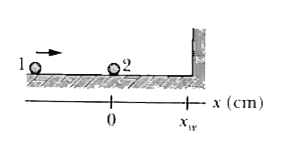
View SolutionIn Fig. , block 1 of mass `m_1` slides from rest along a frictionless ramp from height h = 3.00 m and then collides with stationary block 2, which has mass `m_2 = 2.00m_1`. After the collision, block 2 slides into a region where the coefficient of kinetic friction `mu_k` is 0.450 and comes to a stop in distance d within that region. What is the value of distance d if the collision is (a) elastic and (b) completely inelastic?

View SolutionA small ball of mass m is aligned above a larger ball of mass M = 0.63 kg (with a slight separation, as with the baseball and basket ball of Fig. ), and the two are dropped simultaneously from a height of h = 1.8 m. (Assume the radius of each ball is negligible relative to h.) (a) If the larger ball rebounds elastically from small ball rebounds elastically from the larger ball, what value of m results in the larger ball stopping when it collides with the small ball ? (b)What height does the small ball then reach ?
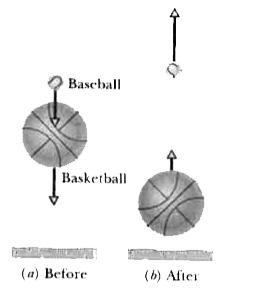
View SolutionIn Fig. puck 1 of mass `m_1` = 0.25 kg is sent sliding across a frictionless lab bench, to undergo a one-dimensional elastic collision with stationary puck 2. Puck 2 then slides off the bench and lands a distance d from the base of the bench. Puck 1 rebounds from the collision and slides off the opposite edge of the bench, landing a distance 2d from the base of the bench. What is the mass of puck 2?

View SolutionIn the two-dimensional collision in Fig., the projectile particle has mass `m_1=m`, initial speed `v_u = 3v_0`, and final speed `v_(1f)=sqrt(5v_0)`. The initially stationary target particle has mass `m_1` = 2m and final speed `v_(2f)=v_2`. The projectile is scattered at an angle given by tan `theta_1` =2.0. (a) Find angle `theta_2`. (b) Find `v_2` in terms of `v_0` .(c) Is the collision elastic?
View SolutionAfter a completely inelastic collision two objects of the same mass and same initial speed are found to move away together at half their initial speed. Find the angle between the initial velocities of the objects.
View SolutionA force `vecF` acts on two particles of masses m and 4.0m moving at the same speed but at right angles to each other, as shown in Fig. The force acts on both the particles for a time T. Consequently, the particle of mass m moves with a velocity 4v in its original direction. (a) Find the new velocity v' of the other particle. (b) Also find the change in the kinetic energy of the system.
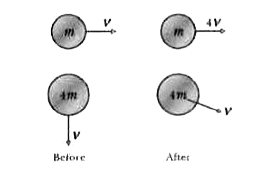
View SolutionA bob of mass `10m` is suspended through an inextensible string of length `l`. When the bob is at rest in equilibrium position, two particles, each of mass `m`, strike it as shown in Fig. The particles stick after collision. Choose the correct statement from the following:
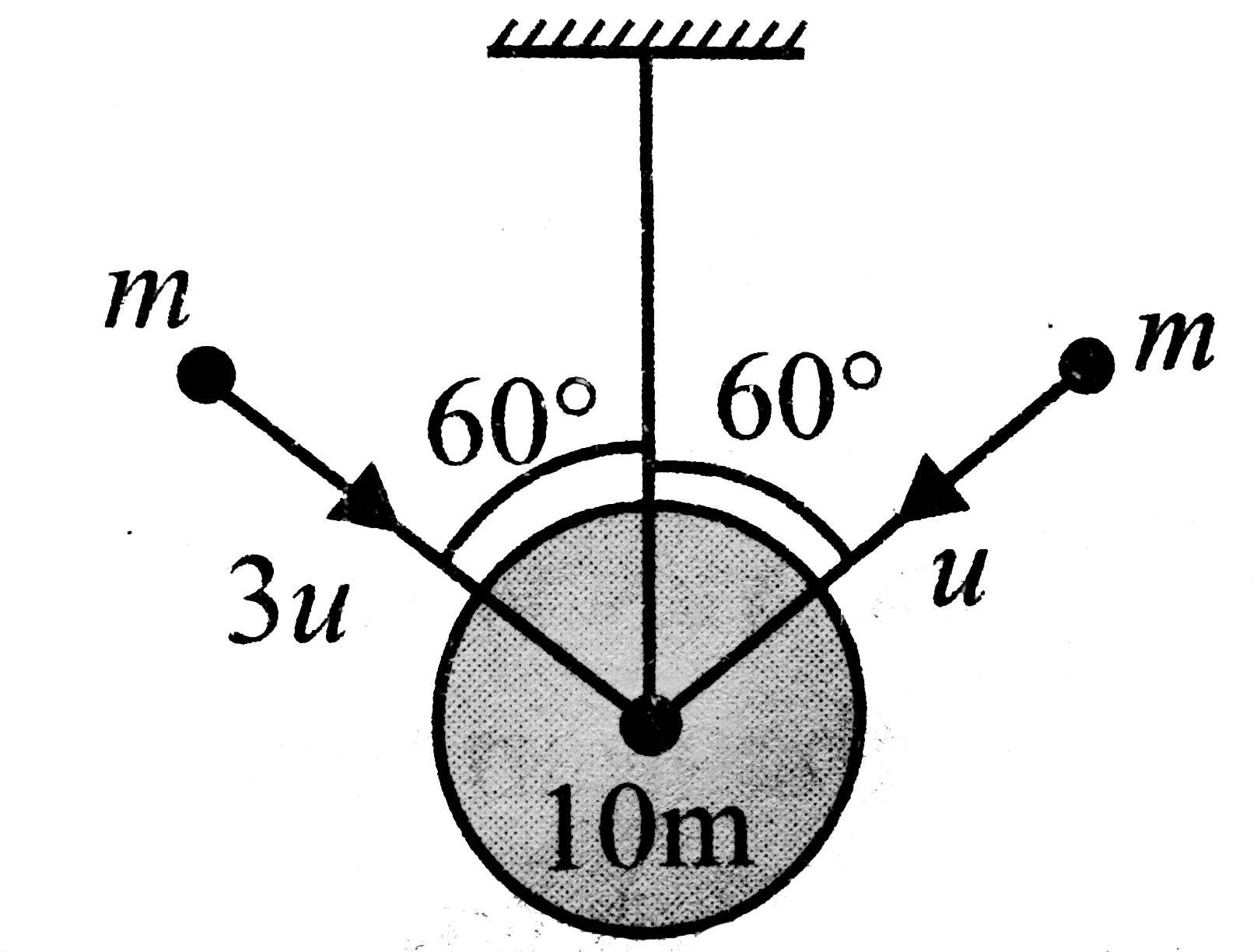
View SolutionA 6090 kg space probe moving nose-first toward Jupiter at 120 m/s relative to the Sun fires its rocket engine, ejecting 70.0 kg of exhaust at a speed of 253 m/s relative to the space probe. What is the final velocity of the probe?
View SolutionConsider a rocket that is in deep space and at rest relative to an inertial reference frame. The rocket's engine is to be fired for a certain interval. What must be the rocket's mass ratio (ratio of initial to final mass) over that interval if the rocket's original speed relative to the inertial frame is to be equal to (a) the exhaust speed (speed of the exhaust products relative to the rocket) and (b) 2.0 times the exhaust speed?
View Solution(a) A rocket set for vertical firing weighs `50kg` and contains `450kg` of fuel. It can have a maximum exhaust velocity of `2km//s`. What should be its minimum rate of fuel consumption
(i) to just lift off the launching pad?
(ii) to give it an initial acceleration of `20m//s^2`?
(b) What will be the speed of the rocket when the rate of consumption of fuel is `10kg//s` after whole of the fuel is consumed? (Take `g=9.8m//s^2`)
View Solution
Problems questions and complete solutions for chapter CENTER OF MASS of RESNICK AND HALLIDAY PHYSICS (HINGLISH) of Class 12